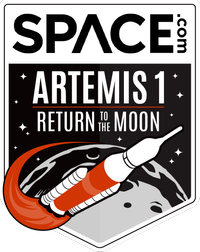Moon vs. Mars: NASA's ultimate destination has varied over the decades
The moon and Mars have battled for precedence in NASA's exploration priorities.


With NASA's Artemis 1 mission launching to the moon this month, Space.com is taking a look at what we know about the moon and why we care. Join us for our Moon Week special report in the countdown to Artemis 1.
NASA is gearing up for the Artemis 1 mission, the first test flight of its ambitious Artemis program that aims to return humans to the moon in 2025 or 2026.
If the flight goes as planned, NASA's Space Launch System (SLS) megarocket will shepherd the Orion spacecraft, along with some cubesats for moon science, into lunar orbit. Orion will spend several weeks orbiting the moon before slingshotting back to Earth with a lunar gravity assist. One goal for this test flight is to show that Orion can survive the entire trip while keeping astronauts safe.
A successful Artemis 1 mission would be a huge achievement for NASA. But a question still hangs in the atmosphere: Should we have skipped the moonshot and aimed straight for Mars?
Related: Every mission to the moon
This debate has been going on since humans first set foot on the moon, and NASA's priorities have changed in accordance with presidential visions for space exploration.
After the success of the Apollo missions, President Richard Nixon axed any further plans for exploration beyond Earth's orbit, according to The Planetary Society. And it wasn't until 1989, 20 years after humans first walked on the moon, that President George H. W. Bush called for returning to the moon and journeying to Mars. In 2004, President George W. Bush reiterated that goal, directing NASA to return to the moon by 2020 and to prepare for a trip to Mars. In 2010, President Barack Obama nixed those plans and instead directed NASA to build a heavy-lift rocket to ferry humans directly to Mars.
Breaking space news, the latest updates on rocket launches, skywatching events and more!
Those plans changed yet again when Donald Trump took office: Instead of aiming straight for Mars, the Trump administration directed NASA to first return to the moon with the Artemis mission as preparation for Mars exploration.
Each approach has its strengths and weaknesses.
Back to the moon
"The moon makes sense because it's nearby," Mark Sykes, CEO and director of the Planetary Science Institute (PSI) in Tucson, Arizona, told Space.com. Back in 2004, Sykes led the PSI team that proposed an infrastructure for Bush's Vision for Space Exploration, which aimed to pave the way for future human spaceflight.
The cost of a crewed Mars mission is currently too high to be realistic, Sykes said. "You don't want to blow the dough on one mission to Mars, and then you're done [exploring] for what, the next century?"
There are also risks to human life to consider.
It takes only three days for a spacecraft to make the roughly 239,000-mile (385,000 kilometers) trip to the moon, so if an emergency were to occur, astronauts could feasibly get back to Earth. At its closest, Mars is 38.6 million miles (62.1 million km) from Earth, meaning it would take six to eight months for a crewed mission to reach the Red Planet. If there were an emergency on Mars, the team wouldn't be able to simply head home.
To Mars!
But those who prefer Mars exploration argue that NASA has already landed humans on the moon, so a new campaign there doesn't offer the same kind of energizing, inspiring goal that a Red Planet mission might.
One point in support of Mars is that the planet has an atmosphere, which makes its surface temperatures a bit less variable than the moon's. However, it does mean that a spacecraft — and the humans inside it — would have to navigate searing temperatures during descent. (NASA's Mars rovers have faced the same challenge with their "seven minutes of terror"; astronauts returning to Earth from stints aboard the International Space Station also face a fiery ride through the atmosphere.) Any spacecraft landing on Mars would have to be able to withstand the harrowing descent through Mars’s atmosphere and keep temperatures survivable inside for the astronauts.
Scientifically, NASA's focus has centered on Mars for decades now. The Lunar Reconnaissance Orbiter has operated around the moon since 2009; since then, NASA has landed two car-sized roving science laboratories on Mars in the forms of the Curiosity and Perseverance rovers.
And while NASA has argued that returning to the moon could inform a future Mars mission, the similarities are limited. If you look at it from a purely scientific point of view, it wouldn't make sense to start with the moon to "practice" for a mission to Mars, Briony Horgan, an associate professor of planetary science at Purdue University, told the Planetary Society back in 2017. Horgan noted that the technology necessary for survival would be vastly different on the moon versus on Mars. For instance, the vast majority of the moon's water is frozen at its poles. On Mars, water is locked up in the rock itself near the equator or frozen in ice sheets underground at its poles.
"I think resource extraction on the moon would inform techniques needed for Mars, but it would not be the same technology," Horgan told The Planetary Society.
— Why we're always so entranced by the moon
— As NASA nears return to the moon with Artemis program, lunar scientists' excitement reaches fever pitch
— The moon's far side could offer a view of the universe even deeper than the James Webb Space Telescope
— Moon exploration site preservation remains uncertain as Artemis era begins
Whatever the destination, long-term human space exploration faces major challenges, including the health risks of space travel, particularly radiation; the logistics of assuring basic living requirements, like food, water and waste disposal; and designing equipment for astronaut-led science experiments.
Until then, although some scientists disagree, Sykes would rather see more spacecraft touch down on the moon — and other worlds throughout the solar system — than astronauts.
In Sykes’s opinion, "There's no science that can be done by humans on the moon that can't be done more cheaply robotically," he said.
NASA's Artemis 1 mission to the moon will launch on Monday (Aug. 29) during a two-hour window that opens at 8:33 a.m. EDT (1233 GMT). You can watch live launch coverage courtesy of NASA and follow Space.com's live updates on the mission.
Follow us on Twitter @Spacedotcom or on Facebook.

JoAnna Wendel is a freelance science writer living in Portland, Oregon. She mainly covers Earth and planetary science but also loves the ocean, invertebrates, lichen and moss. JoAnna's work has appeared in Eos, Smithsonian Magazine, Knowable Magazine, Popular Science and more. JoAnna is also a science cartoonist and has published comics with Gizmodo, NASA, Science News for Students and more. She graduated from the University of Oregon with a degree in general sciences because she couldn't decide on her favorite area of science. In her spare time, JoAnna likes to hike, read, paint, do crossword puzzles and hang out with her cat, Pancake.
